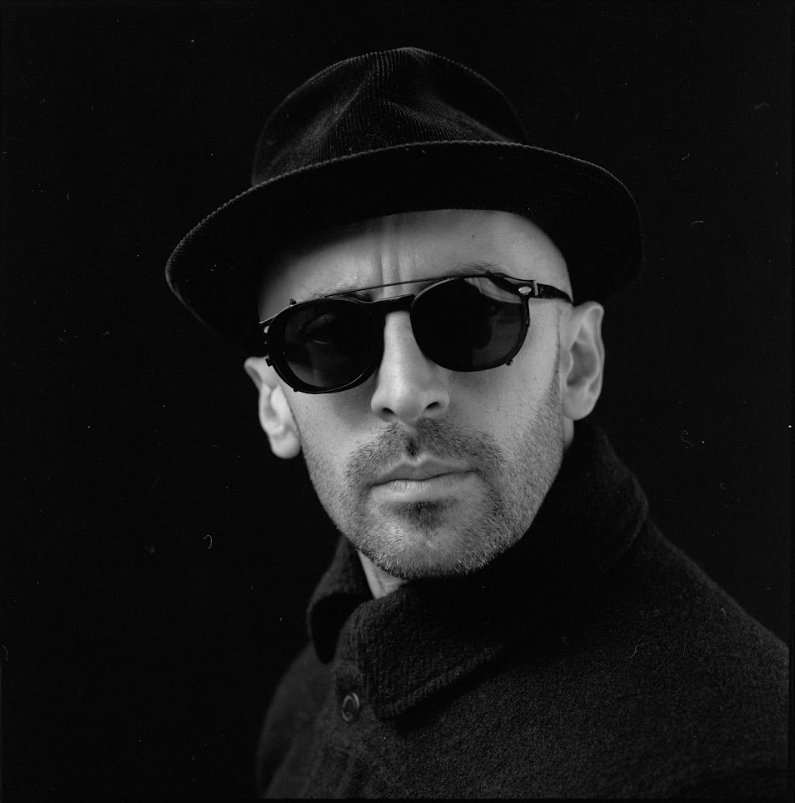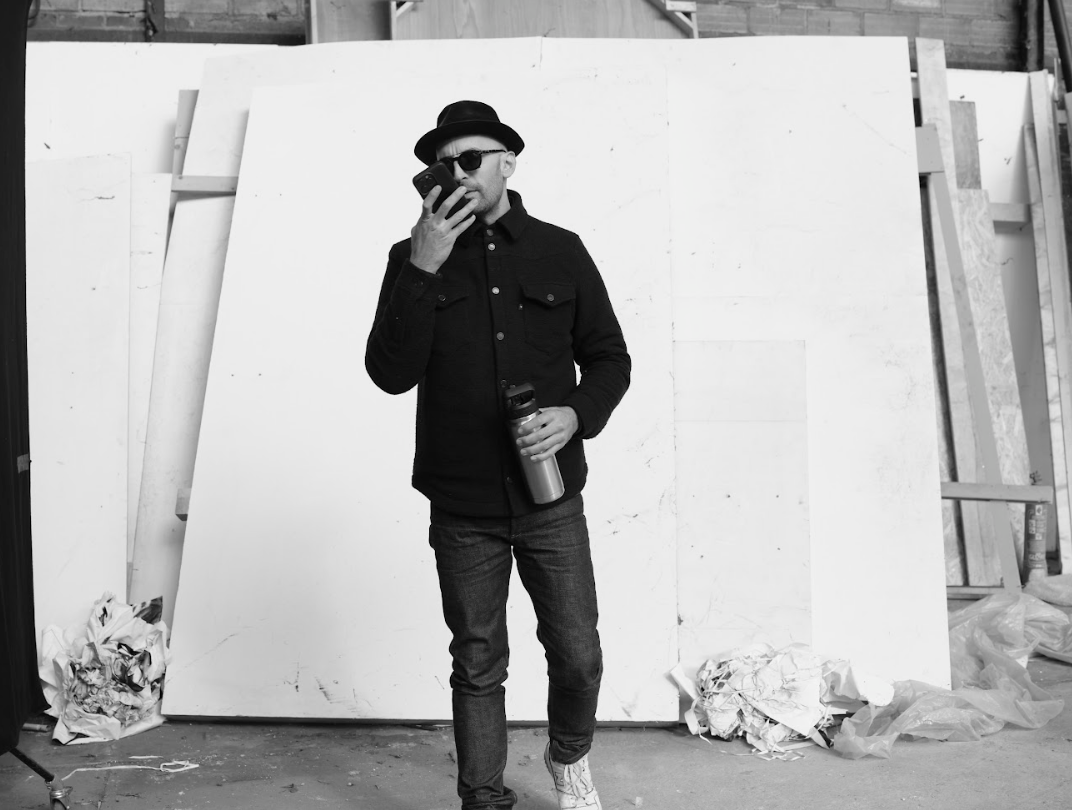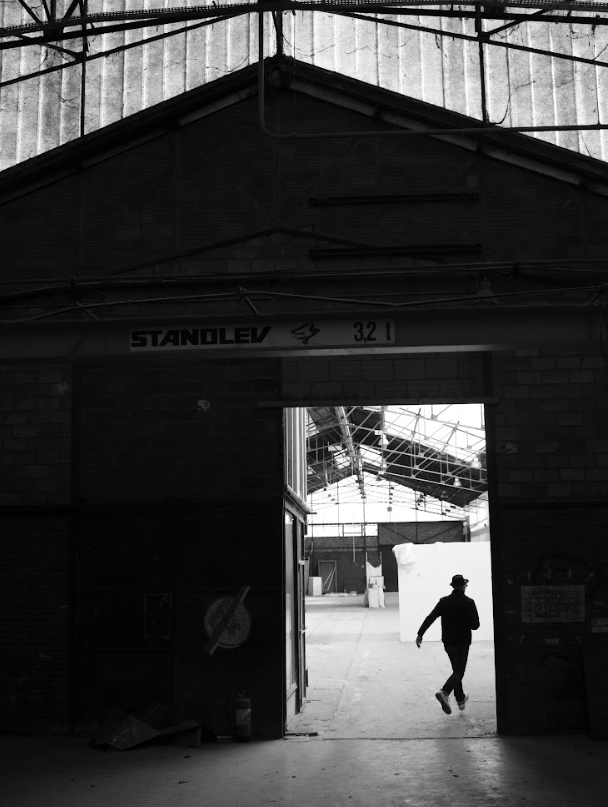Creating a Universal Language with JR
Words by Karen Leong | Photography by Brigitte Lacombe
On the street, it would be easy to pass French photographer and street artist JR by. Shaded by a wide-brimmed fedora and never seen without sunglasses, he cuts a cool yet unassuming figure. Even his pseudonym, abbreviated from his first name, Jean-René, conveys insouciance – he is a deconstructed, populist myth.
JR’s work, however, tends to command the attention of everyone who views it. His images are arresting, not just because of his chosen subject matter and the quality of his work but because the nature of street art means often encountering the law. Traversing a comprehensive list of countries, he has had to identify acceptable forms of artistic expression in one country and what is considered unacceptable and could expedite a lengthy prison sentence in another.
Jimmying photo-collages together of black and white portraits, graffiti slogans, and directly imposing geo-political conflicts and awakenings of the people, like a modern-day Robin Hood using images as his weapon. Much like the outlaw, the artist claims to be offering up his services to humanity. JR’s work is designed to be dispensed among the public, for the public.
In many cities, JR’s art is inescapable. From the winding back alleys of Paris to Times Square in New York, JR creates for the largest art galleries in the world – the streets. He’s become the stuff of legend, with a 20-year crib sheet of exhibitions and projects that have attracted the attention of the Ted Prize, Time Magazine and the Louvre – twice.
As the medium he returns to over and over again, photography purports a belief in the message behind print. This belief in its impact is supported by what JR calls a ‘universal language’, and what I credit more to his ability to render visuals into symbols.
In 2007, JR mounted enormous portraits of Palestinians and Israelis side by side and distributed them across eight cities in both regions. Later on, with the acting chops of Robert De Niro, he commenced his directorial debut with ELLIS, a short film about the swept-under immigrants to the United States, built with his art installations.
JR’s images are primarily composed in black and white and, if judged by modern standards, appear almost intrusive in how they are captured. In his work, his subjects present a fully functional house, a bricks-and-mortar institution of the artist’s own belief – and the statement he intends to make is always clear, if not primitive. He shows rather than tells.
Yet JR seldom adheres to the hope that things will go well. In fact, he works with constant conviction that something will go wrong. Maybe that’s how he gets it right.
Retour à la Caverne, Acte I, 17 septembre 2023, 21h19 (c) JR.
According to JR, his early career plans never included learning or studying art. I wanted to know about the slogan that’s become a mainstay in his artistic identity: Artist Until I Get a Real Job. What metaphorical licence did he hold if he never intended to work in this field?
At the age of 13, the non-artist artist set out to graffiti some walls, with no apprehension: “I never even had an option or a thought, that's how far I was from the art world to even study art in any way. I guess that's what gave me so much freedom to be open-minded. I never saw any borders, so I carry that same energy today in my work for sure.”
The fact that JR has reached this cumulative point today, guided by nothing but the compass of his intuition, is deeply rewarding for the artist: “I didn’t even know you needed to be in a gallery, in the most prestigious art centre of the West, so I’m thankful I had the instinct to hone in on what I did know.”
He credits his sustained work ethic to the many jobs he’s roved between – unloading trucks, working in airports, and waitering. These experiences slowly formed JR’s apathy towards the starving artist trope. Why starve? Just work. Art to JR cohabited a domain altogether separate from feeding himself and paying the bills, and as he grew, so did the desire to protect that. Never making the leap to advertising or commercial sectors of art, he managed to keep this facet of his practice tucked away from the commoditised sheen of the art world.
His artmaking started with writing a name on the wall, just to say he existed. This bubbled into putting other people’s names on the wall, along with their photos – to confirm their existence. This would be considered graffiti by most, but JR doesn’t think of himself as a street artist. He’s never been inspired by the act of vandalism – it’s the idea of the work appearing someplace out of the blue that resonates most acutely.
Even on an elevated field, his start with public artmaking remains a keenly honed instrument of foresight. In a TEDx Talk JR presented in 2022, he said: “I know I think walls are supposed to divide us, but I think I’ve found a way to use walls to bring us together.”
In the favelas of Brazil, he knit eerily close shots of women working in the hills in his customary black and white. The eyes of local women in the community are watchful and quasi-stern; some are caught mid-blink as they encircle the surface area of entire buildings. Transference of dialectic is JR’s favourite way of community outreach, depicting a world and a gallery that isn’t roped off, high-ceilinged or behind glass.
Being arrested is obviously an aspect of JR’s artmaking that hasn't gone well. I ask for clarification and context, and he mentions several countries – Turkey, The Middle East, France, Germany… he’s stopped counting. JR says that while he’s never intended, or learned, to create his art illegally, in certain places it’s not a choice, but something acquired with experience, often in the shape of a fee, or temporary exile. The fact is that JR likes cities that are alive. Istanbul, Cuba and North Korea come to his mind as places where the energy thrums and context is critical.
The approach of working in the same medium in different places allows for fascinating results — an experimentative litmus test of responses that he takes pleasure toying with. Watch and observe the reactions, study the impact of the image on people. If it's public domain, it’s prime real estate for JR’s work.
Over the years, JR has mastered the ability to tightrope the system, which in his case is to avoid getting in trouble by getting chummy with authorities. This happened, most notably, in Mexico, where the artist tells me he made fast friends with the border-patrol agents just as they appeared to be closing in on his arrest. In fact, once the miscommunication wore off, they cheered over the fence. Crazy things are indeed possible, thanks to the connections JR’s work makes.
For JR, treading that line requires much gritting and gnashing of teeth when things fall to the wayside. “Learning how to respond quickly, on your feet, and improvise allows the project to remain interesting, because there is more failure than success. That’s one of the key manners in which one can push yourself further,” he explains.
“Lots of decision making that will be deviating from the beginning. Taking this all into consideration becomes incorporated into the process of this artist. It’s a good balance – on the right track when these elements get combined,” he adds.
I suspect that, over the course of his 30-year artistic tenure, this ethos has allowed JR to mine some of his most gratifying work. My intuition is correct. In 2016, the Louvre approached JR and, at first, he almost couldn’t believe it, wondering why he had been chosen.
“My shock was because it [the Louvre] is to do with highbrow art and for artists who are deceased. I didn’t have much time to think about it,” he recalls.
JR’s instinct with this work was to include people coming from around the world – tourists taking selfies, standing in line, turning their backs to the unmistakable pyramid, and to properly capture this in frame. So, his aim was to turn the camera (and the unveiled joke) back on our selfie-stick-clutching selves. He wanted to make the pyramid go up in a poof of smoke; an anthropomorphic, vanishing trick.
He pulled it off, and in 2018 the museum reached out, asking JR to create a second instalment. This time, he would make the monument appear. With the assistance of 400 volunteers and enough strips of black-and-white paper to swallow the pyramid whole, JR sketched out a new optical illusion of gargantuan proportions. This would be a complete inverse of his original work, with the pointed tip of the museum’s base appearing to extend far deeper into the ground.
Measuring over 15,000 square metres, The Secret of the Glass Pyramid revealed the iceberg-like depths, as imagined by the visual architect, an institution such as the Louvre could plunge to.
At the time of our call, JR was at the tail-end of his greatest feat yet – a restaging of the renowned Opéra Garnier in Paris. Titled Back to the Cave, this work is another almost Sisyphean concoction that involved a surplus of dancers, multimedia elements, weather and an orchestral symphony, unveiled to the public over two days. Roads would be shut for the occasion to accommodate the anticipated 15,000 people passing by.
On his artistic process for this project, JR says he started with a question: “How can I disrupt such a building? It’s such a strong monument – the mind cannot process it to look any different. But the projected cave is actually a giant destruction of the opera. It gathers all the things I like to portray in my art the most: gathering people and raising questions. At this level, there’s so much risk. But if it functions, it functions.”
As I started writing this story, the event’s release date was just 10 days out and there was a lot left to be done – choreography, finalising the score, questions of lighting, architectural rescaling of the building. The undertaking was monumental, but there were approximately 200 people working on this project alongside JR.
“At this point, everyone knows their part. So that risk is measured. People have waited for their part for a long time,” he says, certain of the fact that the past 15 years have guided him directly to this moment.
Unsurprisingly, the response was overwhelmingly positive. With the backing of [South Korean DJ] Peggy Gou, JR received an outpouring of praise on social media, with everyone clearly touched by the proverbial show of light felling darkness, the intricacy of each hand-pasted lithograph and the seamless melding of choreographic and technological prowess on display. This was a symphony of the arts.
JR admits to never knowing what he’s doing six months ahead, so it’s impossible to predict what comes next. He finds this uncertainty reassuring, as it means anything could happen – the path is loose and winding; the possibilities are boundless.
For those looking to get it right, I ask JR if he has any nuggets of wisdom to dispense. “No advice,” he says. “But notice how right now, art is so accessible to everyone in the way of sharing and making it… That’s pretty amazing!”
“Always think of the message you are pursuing – why are you doing what you are doing? That is the key that will unveil the rest of your journey, because the message has to be expelled in any way out of you. It's not to please. It’s not just how to survive as an artist, but what’s the intention? Concentrate on the thematics and define what you want to share.”
Show, and time will tell.




